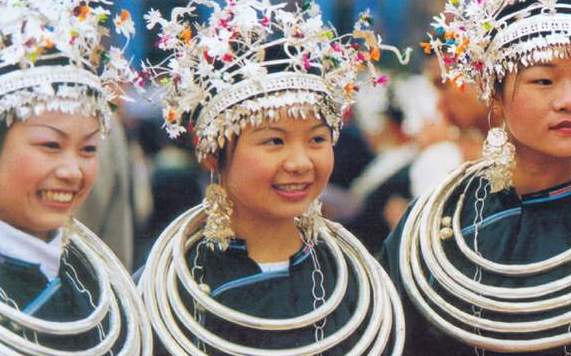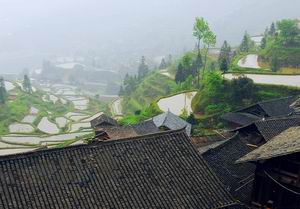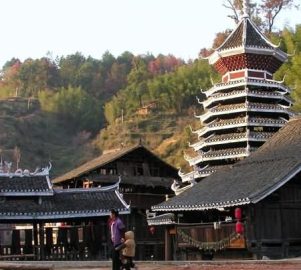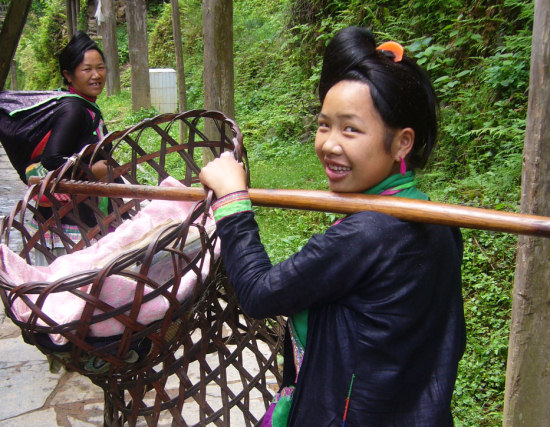Dong Ethnic Clothings

The Dong ethnics living in remote river valleys have had little contact with outside groups. Mountainous seclusion has helped preserve the ancient virtually unchanged for hundreds of years.
Courting festivals, rich in polyphonic singing and simple dances, offer occasions for young Dong women to dress in their finest handwoven, dyed, and embroidered clothing, ornamented with an abundance of silver jewelry that jangles musically on their festive aprons.
On such occasions, an unmarried women presents a special handwoven bag or vest to the young man she most favors. The young man, if he in turn admires the women, will sing spontaneous praises of her skillfulness at the loom. A person's ability to sing is equally praised among the Dong, and is another important factor in the selection of a mate.
Silver ornaments
Silver ornaments are another important aspect of a Dong woman's dress, especially among those in the south. Jewelry styles, though basically the same among the various Dong groups, do bear some distinctions such as the silver "weight" that hangs down the back of a woman's jacket.
This ornament, worn by many southern Dong women, holds the traditional backless under-apron in place. Several stories relate to the symbolism of wearing this distinct Dong ornament. Some say it is worn in remembrance of their ancestors, who, according to legend, were once held captive in ropes. Others hold the belief that by wearing this silver, they will avoid evil by thwarting malevolent spirits, thus ensuring a long life.
Additionally, it is viewed a having both practical value and beauty, as well as a visual record of family wealth; a rich family's daughter would wear a much larger and heavier silver back ornament than a poor family's.
The back silver piece in some areas is formed in a shape known as the "mandarin duck pattern", which is considered an auspicious motif. This design (of two concentric circles oppositely joining) is also embroidered on baby carriers, and collars of women's jackets. In other Dong areas, the women wear heavy octagonal or square back silver pieces. These silver back ornaments are worn everyday, whether working in the fields or staying at home.
Making traditional costumes
The making of traditional costumes continues to play an important role in a women's life. Each Dong dress group has its own traditions and produces distinct clothing that reflects its particular customs, history and beliefs. Cultural identity is thus maintained through the making and wearing of such garments.
Festivals and especially market days reveal the wide array of dress differences found among the Dong people. Much can be gleaned from one glance at a woman's costume as to not only where she comes from, but also how diligent she is as a worker and how creative an artist. For this reason, young women continue to learn from their mothers and grandmothers the technical intricacies of weaving long-cherished patterns into their cloth, the tedious hours of dyeing fabric to perfection, the ability to spin a fine thread and the patient skill needed to elaborately embroider garments. In some Dong areas, years of labor go into the making of one complete festive and marriage costume.
Another factor is responsible for the preservation of ancient textile techniques, styles and motifs-a woman's chances of marriage are closely aligned to her textile skills. One of the criteria a Dong man looks for in a prospective wife is her proficiency in embroidery, dyeing and weaving. A young girl begins learning the textile arts at the age of seven or eight, so by the time she reaches marriageable age, she'll have prepared one or more sets of festive clothing, painstakingly created to show her ability.
The countless hours of needlework are exhibited during the many courting festivals held throughout the year, when women parade their most exquisite handmade costumes in the hope of attracting a desirable young man.
In the south, both festive and everyday wear are woven from cotton grown in nearly fields. The spinning wheel, an indispensable item of a woman's dowry, is found on the spacious wooden porch of the Dong's sturdy fir house, where women gather together to spin smooth cotton they weave will be transformed, through dyeing, into a unique iridescent fabric.
From the age of 13, Dong women working on floor looms produce yards of plain-woven cloth to be used in traditional clothing. The Dong are famous for their coloring brocade weavings that are incorporated into aprons, shoulder bags, baby-carriers and household items. The most common brocade motifs are camellias, human figures, animals and geometric patterns. Both floor looms and small belt looms are used to weave narrow bands of simple yet beautiful designs for straps and apron ties. In Guizhou's Congjiang and Liping counties, women weave delicate designs on low foot-pull body-tension looms containing over 300 supplemental harness sticks.
Must-see Villages in Guizhou and Guangxi
Basha Zhaoxing Tang'An Xijiang Sanjiang Longsheng
Frequently asked questions in Guizhou





